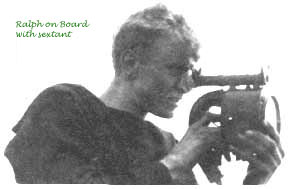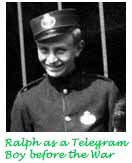

|
|||||
| Ralph Stobart Robson, signalman, life in the British Royal Navy World War Two, sinking of Prince of Wales and the Repulse, Singapore | |||||
|
|||||
|
|||||
|
0ne day we saw that there was a new vessel moored. I discovered that it was a Dutch Tug, "Thames", a vessel I had last seen in the North Atlantic. She was towing the front half of a merchant ship which had been torpedoed and which had broken off at the rear of the bridge. We had approached her to ask if she wanted any assistance. She said "no" but would we report her position. Now here she was off the African Coast. There were some men standing around her stern. As we approached they hailed us in English and asked if we would like a cup of coffee. When we replied "yes" they motioned us to a boarding ladder. As we swam towards the ladder my mate said, "I've never drunk that". I said, " Drink it, and smile". A good chinwag was held. They told me that the ship they had rescued had been towed into Iceland and after she had been made properly seaworthy was now sailing again as they had seen and spoken to her. She had been towed to Glasgow and had been fitted with a new aft-end. They had noticed the little canvas bags that we wore around our waists and asked what they were. We took them off and opened them to show pieces of bread and butter. They smiled hugely and the mate said "Throw them to the birds. You will get a proper meal today". We certainly did. Those Dutchmen certainly knew how to eat. During the conversation I accidentally mentioned that I had been on board the Prince of Wales and was sunk on the Repulse. I had never mentioned the subject since leaving Singapore, mostly I think because the little yellow men had bested us. The Dutchmen were intensely interested and questioned me closely. My friend was just as amazed as he knew nothing either. Eventually, after saying our goodbyes, we dived off the tug and swam ashore. Two days later after a short swim we walked down past the can buoys on our way to walk along the shore. To our horror we saw swimming past the shadow of the buoy the shapes of what were undoubtedly two sharks. As the nearest house was the Naval Signal Station on the headland above us we ran up the slope. Bursting into the Station we gabbled out our tale. The Yeoman in charge got on to the blower and instigated what was to turn out to be a great hue and cry. We slowly walked down and along the beautiful beach. Here we were to encounter what was to be the second shock of the day. I noticed a movement amongst the rocks. Bending down I saw a largish member of the lobster family. I could see that this was one of the nipperless ones. Without thinking I bent down and hauled him out of the water before either he or I could react. It was a beauty - more than a foot long. As I stood there admiring it (my mate wouldn't touch it) a native suddenly appeared. He made a gesture which indicated that he would love to have it. Thinking of his starving wife and family I handed it over. In a flash he tore off the lower part of the carapace and commenced to eat the wriggling body - my mate was nearly sick. The native was all smiles and salaams - the wander along the beach was terminated. A few weeks before, I had been wandering down the main street in Mombassa when I had noticed a store sign advertising the dispatch of food parcels to the U.K. When I entered the shop it turned out the owner came from a district north of Bombay and that his family owned two shops, with another one in Nairobi. He was a nice little fellow and he sat me down to coffee and biscuits, and I saw him one more time before leaving Mombassa. |
|||||
|
|||||
